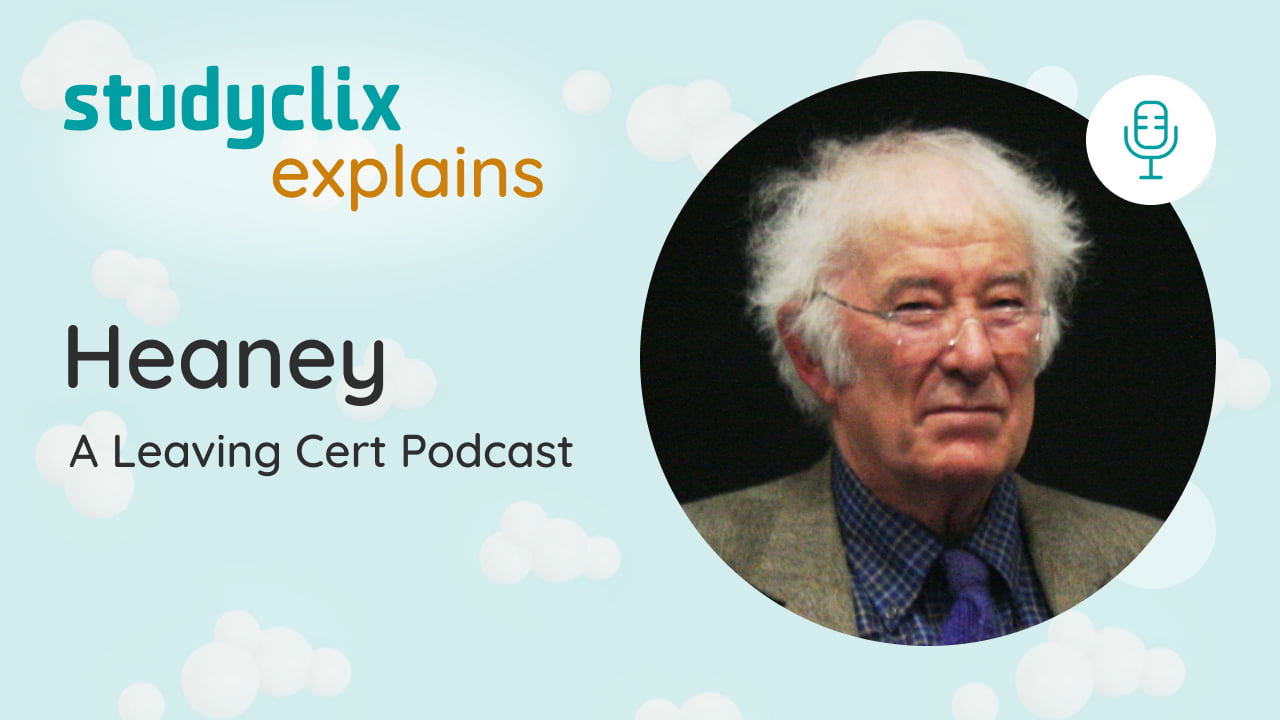

By Laura Daly
Listen to our H1 audio notes on the poet Seamus Heaney

My name is Laura Daly, I’m an English teacher from Dublin and I’m going to be taking you through an exam-focused podcast on Seamus Heaney.
There are 13 Heaney poems on the course, which is a lot, so be sure to skip to the ones that your teacher has covered in class. Remember you need to discuss four in-depth and refer briefly to two more for an H1. The Youtube video below is broken into chapters so you can just focus on the poems you are studying.

I recommend having each poem to hand while you listen to the podcast. You can find all of these poems by looking them up on Google. I have also included the transcript of this podcast so you can take down the notes you find useful.
Have a listen below, or wherever you get your podcasts!
Or if you prefer, you can watch listen to it on Youtube it instead!
If you have ideas for the Studyclix Explains channel, topics you'd like us to cover, or guests you'd like us to get on, please let us know. You can follow Studyclix on Facebook, Twitter, Instagram, and Snapchat and share your ideas with us there.
Otherwise, drop us a line at info@studyclix.ie

Below is a transcript of this full podcast packed full of top tips and H1 notes. Make sure to copy these into your notebook to use on the day of your exams!
Hi there, welcome to this Studyclix podcast on Seamus Heaney. My name is Laura Daly, I’m an English teacher from Dublin and I’m going to be taking you through an exam focused podcast on Seamus Heaney. Heaney is a literary icon, a source of cultural pride and Nobel prize winner. But do not be intimidated, in terms of being a Leaving Cert poet he is extremely accessible to students and a great choice to focus in on for the exam. There are 13 Heaney poems on the course, which is a lot, so be sure to skip to the ones that your teacher has covered in class. Remember you need to discuss four in depth and refer briefly to two more for a H1.
Just like in a Leaving Cert essay I’m going to follow a structure to give this podcast coherence. First of all, I’m going to tell you a little bit about Heaney’s background and his poetic influences, giving you a brief cultural context for his poetry and outline some key stylistic features. Then we will move towards the main section of the podcast analysing each of the poems on the course with a with a view to condensing them into the bitesize elements to make them easy for you to remember.
These elements will include looking at:
Imagery and Sound techniques Stylistic FeaturesFinally, I’ll give you some top tips in terms of exam prep.
So in terms of Heaney’s background, we know so much about him, it’s a case of selecting a few key elements for your essay that will lend to understanding his influences and his social and cultural context. The social and cultural context in simple terms, means what was happening in society when the poet was growing up or writing, that would’ve impacted their views and therefore, their art. So who and what, influenced Heaney?
Well Heaney was born in County Derry in 1939 and reared on the farm Mossbawn until 1953, after the untimely death of his younger brother caused the family to move. Many of you will be familiar with the poem ‘Mid Term Break’ from Junior Cycle which deals with his brother’s death. The farm Mossbawn and the North feature heavily in Heaney’s work, both the personal and political aspects are explored in his poetry.
Writing during the Troubles means that violence and Irish identity are key issues that emerge in his writing. He moved from the North, from Mossbawn to Belfast and then to the Republic of Ireland living for a time in Wicklow and then Dublin. He also spent time working in America. The landscape of Ireland and beyond holds a fascination for Heaney, becoming a metaphor for creativity and identity in his poems ‘Postscript’ and ‘Bogland’, respectively.
As well as abstract or ideological themes like identity, poets are human beings, so of course their personal relationships impact their writing and we see this also in Heaney’s poetry. Three of the poems on the course deal with Heaney’s wife, Marie and the different stages of their romance; ‘The Underground’, ‘The Skunk’ and ‘Tate’s Avenue’. We also see Heaney’s relationship with his father feature in many of the poems such as; ‘A Call’, ‘The Harvest Bow’ and ‘The Pitchfork’.
Another thing to note about Heaney’s influences is that the writing process itself, the production of art, often a preoccupation of poets, is something explored in his poetry; we see this in ‘The Forge’ and ‘The Pitchfork’.
During his lifetime, Heaney was widely recognised and had a very successful career. He began as an English teacher, before becoming a lecturer and full time poet. Among his many roles and accolades he was named Boylston Professor of Rhetoric and Oratory in Harvard, one of the university’s most prestigious offices; he became Professor of Poetry at Oxford University; he served for five years on The Arts Council in the Republic of Ireland; he was heavily involved with the Field Day theatre company; he was made a Commander of the Order of Arts and Letters by the French Ministry of Culture, and he received the Nobel Prize for Literature in 1995. However, if we are purely focusing on the exam get your pens ready now, I’m going to give you a few key bullet points from his biography to take note of for your essay: